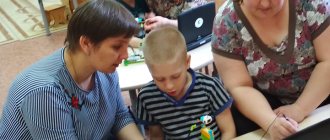Communication as a condition for meeting the needs of a preschooler
Before a child develops the need to communicate with others, he reaches out to others for the sake of comfortable sensations, for the sake of gaining security, for the sake of receiving impressions. These needs appear from the first days of life.
By the age of 3, cognitive needs come to the fore. Where can she be satisfied if not by turning to an adult?
Kids need to make so many discoveries and understand how this world works that they constantly need explanations and help from parents, educators, and older brothers and sisters.
Younger preschoolers not only ask questions. They strive to express their Self. They need to address it to someone: “I myself!” Or draw the attention of the same children to yourself, saying “These are my toys”, “Look what doll they gave me.” For such self-affirmation, viewers, listeners, and partners are needed. Communication provides them.
By the age of five, the need for respect is formed. Children demonstrate what they have already learned and what they know or can do. When communicating with peers, edifying phrases are often heard: “Look how you should do it,” “Do it as I do!” In addition, in middle preschool age, boys and girls need equal play partners. Children's games are nothing more than an organized form of communication.
For older preschoolers, the need to talk about their impressions, convey interesting information and establish their authority among their peers is becoming more urgent. Therefore, their communications cover an increasingly larger circle of peers. Preschoolers are already good at identifying moral qualities, so they are drawn to those peers who are closer to them.
We have provided a small list of needs that preschoolers satisfy in communicating with others.
Communications that arise on the basis of certain needs, motives, as well as the verbal and non-verbal means used, form stable forms of communication.
For children, almost all interactions are tied to specific situations. With growing up, forms of communication in preschoolers develop, and they acquire an extra-situational character.
The concept of pedagogical communication
Ped. communication is a dialogue between a teacher and students or pupils that has a professional orientation. This form of teaching or education is necessary to create a favorable psychological atmosphere in the team, so that the presentation of material is not a dry listing of facts.
The teacher gives the basics of communication
For your information! With such communication, children perceive information coming from an adult more readily.
Although it should be borne in mind that much depends on the personality of the teacher. Childcare should be as positive and friendly as possible, but with elements of a certain severity to maintain discipline in the children's team.
Dialogue with children is conducted competently
Heuristic conversation as a teaching method
In pedagogy, heuristic pedagogical communication is teaching in the form of question and answer. It was created by Socrates in Ancient Greece two thousand years ago. In the mid-50s of the last century, heuristic conversation became the subject of active study, since it was inherently well suited for solving issues of teaching children with special needs.
As a result, a system of certain techniques was developed, which made it possible to apply it in types of communication between an adult and a preschool child.
The essence of a heuristic conversation is that the teacher does not present ready-made knowledge and solutions to the problem, but pushes his interlocutors to the right solution through correctly posed additional questions.
For your information! Each answer to such an additional question is a step towards the correct answer to the main question. All leading questions are interconnected by a common theme and follow from one another.
Moreover, each such question is asked not mechanically, but during a conversation between the teacher and preschoolers, the topic of which is the problem raised.
With this form of communication, the teacher’s ability to conduct a conversation and encourage his students to engage in it until the main goal is achieved is most clearly demonstrated.
How do preschoolers communicate with others?
If we briefly consider how forms of communication progress in preschool age, then it is best to turn to the work of the famous psychologist M.I. Lisina, who identified four levels of communication from infancy to 7 years, designating them as a form:
- Situational-personal
- Situational business
- Extra-situational-cognitive
- Extra-situational-personal
The first ones in this list are formed earlier, based on specific actions, objects, and experiences. By older preschool age, they do not disappear, but partially give way to more developed forms that are not tied to the situation. These changes are facilitated by the development of children's speech and verbal-logical thinking.
The highest form of communication for preschool age is one that promotes understanding of the meaning of human relationships, as well as the assimilation of the norms and values of society. Consequently, this is an extra-situational-personal form of communication.
The basis for organizing communication between preschool children
Definition 1
Communication is a specific form of human interaction with other people as members of society.
The basis of communication from a psychological and pedagogical point of view is a personal approach, which is focused on the comprehensive development of the child’s personality, as well as on his interaction with other children in the framework of various types of activities (educational, work, play, etc.). Reliance on this method is due to its systematic nature.
Definition 2
The psychological and pedagogical foundations of communication among preschool children is one of the new disciplines, representing a set of theoretical developments and experimental studies that provide a great opportunity for understanding the development of a child’s personality.
Are you an expert in this subject area? We invite you to become the author of the Directory Working Conditions
Based on this definition, the psychological and pedagogical foundations of communication are represented by two lines - theory and practice (experiment).
The theoretical line of the psychological and pedagogical basis of communication represents the rationale for the basic type of activity within which interaction takes place between the teacher and students.
The second line is experimental (practical), based on the parameters of interpersonal interaction, which includes three main components: cognitive, behavioral and affective (emotional).
Forms of communication between preschoolers and peers
In the period from 3 to 7 years, forms of communication with peers are observed, which are consistently updated from younger to older preschool age:
- Emotional-practical
- Situational business
- Non-situational business
Communication among younger preschoolers is stimulated by emotions or practical action. Kids can simply run up to each other with a joyful smile, and this is already a sign that they are interested in communicating. It is not so important how long their communication will captivate them. The emotionality of contact is valuable.
The children's joint actions are still short-lived. They can make Easter cakes nearby or roll cars. They can demonstrate how far they throw a ball or slide down a slide. However, the emotional-practical form of communication provides the basis for the formation of initiative in communication.
In middle preschool age, children's business communication actively develops. This is due to the fact that the role-playing game progresses story-wise. Preschoolers no longer play just side by side, but together, choosing more complex plots, distributing roles, and agreeing on the rules.
Some business qualities are demonstrated, but they are tied to situations. For example, a child may act as a strict controller in the game in accordance with the chosen role, but behave timidly in ordinary contacts.
Extra-situational relationships allow you to shift attention from the actions of the communication partner to the person himself. Unexpectedly, the preschooler begins to see his play partner as an interlocutor, a person with his own interests and preferences. Another thing is that the revealed personality traits can either please or repel. Both a boy and a girl can tell their yesterday’s friend that they no longer play with him, because he takes other people’s toys without permission, offends others, etc.
Among children, a preschooler acquires behavioral skills, learns mutual understanding, and discovers social values.
The behavior of peers serves as a kind of mirror, allowing the child to see himself from the outside. And developing social intelligence helps the preschooler to notice the nuances of facial expressions and statements that previously escaped attention.
Consultation for educators on the topic “Communication and its role in the development of a preschooler.”
Municipal preschool educational institution general developmental kindergarten No. 12 “Rainbow”
Consultation for educators on the topic
“Communication and its role in the development of a preschooler.”
Prepared by teacher: Stolyarova Anna Nikolaevna
2019 – 2022 academic year
Communication and its role in the development of a preschooler.
The study of communication shows the complexity, diversity, and manifestation of this phenomenon. The complexity of communication requires the identification of its components and a description of the structure.
One of the frequently used approaches is that there are three interconnected aspects of communication:
- informative (or communicative), which consists in the exchange of information between communicating people;
— interaction (or interactive), which manifests itself in the exchange between participants in communication not only of knowledge, ideas, states, but also actions;
- understanding (or perceptual), which is the progress of perception, evaluation and understanding by communication partners of each other.
As studies by L.S. have shown. Vygotsky, communication plays a decisive role not only in enriching the content of a child’s consciousness, in the child’s acquisition of new knowledge and skills; it also determines the indirect structure of higher, human mental processes.
The role of communication in mental development was also studied by A.V. Zaporozhets, M.I. Lisina, Z.M. Boguslavskaya.
The importance of communication for education.
Communication is a socio-psychological phenomenon, sometimes considered
as a psychological category. Communication is a process of interaction between people in which the persons participating in it have a more or less strong influence on the claims and intentions, on the thoughts, states and feelings of each other.
Communication is the exchange of information between people, their interaction. Communication is the primary, dominant form of human relationship with the environment. The meaning of communication is the content side of a sign as an element that mediates knowledge of the surrounding reality. Entering into communication, i.e. When approaching someone with a question, request, or order, people necessarily set themselves the goal of influencing the other person and achieving understanding. The goals of communication reflect the needs of joint activities of people. The purpose of communication is why a person has this type of activity.
The main condition for a child’s mental development is his communication with adults. Communication between young children and adults that is insufficient in quantity and poor in content leads to serious consequences, called hospitalism. Despite good nutrition, hygienic care and medical care, children growing up in conditions of “communication deficit” are sharply behind in their mental as well as physical development.
The need for emotional communication, which has enormous positive significance for the development of a child, can also lead to negative manifestations. If an adult tries to constantly be with the child, then the child gets used to constantly demanding attention and is not interested in toys.
With the right methods of education, direct communication (communication for the sake of communication) gives way to communication about objects, toys, which develops into joint activity between an adult and a child. An adult not only satisfies the child’s growing needs and teaches him how to operate with objects. He evaluates the child’s behavior in a certain way, encourages him with a smile, frowns and wags his finger if the child does not act as he should. Thanks to this, the child gradually acquires positive habits and learns to behave correctly.
The growing need to communicate with adults conflicts with the possibilities of communication. This contradiction finds its resolution in understanding human speech, and then in mastering it.
Thus, a child’s communication with adults and peers plays an important role in mental and mental development, which affects upbringing.
Communication influences all achievements of preschool age: the development of the cognitive sphere and the formation of the foundations of a child’s worldview; on the occurrence of voluntary behavior, the ability to act in accordance with the rules; on the formation of personal identity.
Deprivation of the need for communication, narrowness and limited contacts with adults and peers leads to disturbances in the development of the cognitive sphere (the formation of generalizations, classification, mediation of memory, arbitrariness of attention, and speech development are impaired). Children brought up in boarding schools are characterized by reduced emotionality, stinginess in expressing their experiences, aggressiveness and anxiety, and inability to empathize. This is shown in the studies of I. A. Zalysina, Yu. V. Egoshkin, T. N. Schastnaya, E. O. Smirnova.
In preschool age, one of the conditions for the development of communication is the development of the child’s role-playing play. Human relationships that exist in the world of adults become the subject of children's play activities, where the adult is present indirectly, in an ideal form. From the point of view of D. B. Elkonin, play is a way of mastering social reality, which expresses the child’s connection with society. Story-based games can have an impact on the growth of communication skills, emotional understanding, social perspective taking, and the development of empathy.
Another condition for the development of communication is the development of arbitrariness of behavior, the ability to act according to the rule.
The condition for the successful development of communication is certain features of the cognitive sphere. The ability to understand the intentions, feelings, desires of another person is associated with overcoming egocentrism and determines the success of communication.
Communication of a preschooler is non-situational in nature. M.I. Lisina identifies two main forms of communication with adults. In the period from 3 to 5 years, an extra-situational cognitive form of communication between a child and an adult appears. The motive of communication is cognitive, that is, the child perceives the adult as a source of knowledge about the surrounding reality. The leading need that a child seeks to satisfy through communication is the need for respect from an adult. Speech becomes the main means of communication.
At the end of preschool age, an extra-situational personal form of communication is formed. The content of communication becomes relationships, norms and rules of coexistence of people, that is, the motive of communication is personal. The need for mutual understanding and empathy of an adult is the main one for non-situational personal communication. The leading means are speech.
In preschool age, he continues his development and communication with peers. From the age of 4, a peer becomes a more preferred communication partner than an adult. The reason is that self-awareness in preschool age is formed through comparing oneself with peers in the process of communication. M.I. Lisina, E.O. Smirnova proved that by comparing himself with the children around him, the child more accurately imagines his capabilities, which he demonstrates in different types of activities. In the process of communicating with peers, children’s self-esteem develops, which becomes more adequate. Already at preschool age, popular and unpopular children can be distinguished. Children who are rejected by their peers in kindergarten are likely to be rejected by their peers in elementary school. In adolescence and adolescence, it is very likely that they will have problems with social adaptation. In domestic psychology, research by T. A. Markova and T. A. Repina has proven that the reason for the popularity of preschool children is the child’s playful, cognitive, and communication abilities and moral qualities. E. O. Smirnova believes that the main quality that determines the popularity of a preschooler is the child’s attitude towards a peer, namely: sensitivity and interest in a peer, the presence of prosocial actions, empathy for another child.
During preschool age, children’s communication with each other changes significantly in all respects: the content of needs, motives and means of communication.
Throughout preschool age, the form of communication with peers changes. A.G. Ruzskaya identifies several forms of communication with peers.
Children aged 2–4 years are characterized by emotionally practical communication. The content of communication with peers appears in the form of a desire to participate in joint practical activities (actions with toys, manipulation, changing clothes, crawling, running away).
The main content of the communicative need is to attract attention to oneself and receive evaluation of one’s actions. Children listen to each other little, the main thing is to demonstrate themselves. Children often act side by side rather than together.
This form of communication contributes to the development of children’s initiative, since communication with peers presupposes equality; favors a sharp expansion of the range of emotions – both positive and negative; communication contributes to the development of self-awareness through the opportunity to see one’s capabilities. The main means of communication are locomotion or expressive movements. Contacts are extremely situational.
Situationally, a business form of communication with peers is typical for children aged 4–6 years. At this age, the peer begins to surpass the adult in attractiveness and becomes the preferred communication partner. This is due to a change in leading activities, says A. G. Ruzskaya. A role-playing game is formed, where the child models human relationships. This requires the interaction of several partners. The content of communication is business cooperation. During situational business communication, preschoolers are busy with a common task, which requires agreement in achieving a goal and fulfilling a role. There are two types of relationships in the game: real and role-playing. Children clearly distinguish between these two types of relationships. The difference between such cooperation and the cooperation of adults is that for preschoolers it is not the result that is important, but the process. Interactions are situational in nature. The main content of their communicative needs is the desire to gain recognition and respect from their peers. The desire to attract a peer and sensitivity to his attitude towards oneself acquires maximum brightness at this time. These relationships act in the form of an “invisible mirror”. At this time, the preschooler sees himself (his attitude towards himself) in his peer and sees only the positive; Later, he begins to pick on his peer, but only his shortcomings. The child constantly compares himself with his peer and is closely interested in everything his peer does. Among the means of communication at this stage, speech begins to predominate - children talk a lot to each other, but their speech remains situational.
Non-situational - business form of communication develops by the age of 6-7 years. This turning point is outwardly manifested in the emergence of selective attachments, friendships and the emergence of more stable and deeper relationships between children. Appeals to peers at this age are increasingly acquiring an extra-situational character. Children tell each other about the events of their lives, discuss plans for joint activities, their own and other people’s actions. In games, the rules of the game come to the fore. Conflicts often arise due to non-compliance with rules. More and more contacts are carried out at the level of real relationships and less and less at the level of role-playing ones. The image of a peer becomes more stable, independent of the situation and circumstances of interaction.
A huge role, says M. I. Lisina, is played by the influence of an adult. When children communicate with each other, it helps them to see in their peers a person equal to themselves and to respect him. Communication, like any other activity, ends with a certain result. The result of communication can be considered as its product. Among them, relationships and self-image occupy an important place.
Thus:
• Communication in preschool age determines the development of the cognitive sphere, voluntary behavior, and self-awareness.
• Conditions for the successful development of communication are the development of role-playing games, features of the cognitive sphere (overcoming egocentrism) and the formation of voluntary behavior, the ability to mediate one’s behavior by certain norms and rules.
• In preschool age, two extra-situational forms of communication with adults are formed: extra-situational cognitive and extra-situational personal.
• From about 4 years of age, a peer becomes a more preferred communication partner than an adult. In preschool age, in a peer group one can distinguish between popular and unpopular children, who differ in different sociometric status. During preschool age, A.G. Ruzskaya distinguishes situationally business and non-situationally business forms of communication with peers.
Forms of communication between children and adults
Communication with adults is, in essence, interactions in the “zone of proximal development,” since a preschooler uses his potential and fills in the blank spots in his knowledge.
Starting from the age of 3, the baby becomes an active explorer of everything around him.
The need for cognitive activity and the desire to get answers to puzzling questions directs him to his parents or other significant adults. Interaction takes on an extra-situational character and is realized in two forms of communication that follow each other.
Extra-situational-cognitive communicative form
Communication can be situational in nature, and the child may ask to draw the same bunny that he has in his hands. But increasingly, interest goes beyond situations. The preschooler asks where the bunny lives, if he has a house, and immediately continues to ask questions about all the animals he knows.
An adult is an expert for a child who knows everything and can do everything. The kid accepts any answer. Often these answers are presented in a fantasy or fairy tale context. And how else can a child answer the question in style, does the Bear sing songs to her Little Bear?.. Nevertheless, the preschooler satisfies his current cognitive interest.
Cognitive communication with an adult gives the child real ideas about the world and expands his understanding of the cause-and-effect relationships between surrounding objects and phenomena.
Extra-situational-personal form of communication
The older a preschooler gets, the more he understands that the social environment is much wider and more diverse than his usual environment. The child realizes that he needs to learn how to behave and act correctly in different situations. Moreover, he sees the different behavior of his peers, which leads him to the conclusion that not everyone behaves as they should.
The preschooler has questions for elders in order to understand the meaning of relationships between people. To some extent, the older preschooler checks his point of view to see whether it coincides with the position of the adult. This is how generally accepted social norms are assigned.
By talking with adults, the child learns standards of expression and behavioral cultural norms. The preschooler begins to develop his own authorities. To understand a certain situation, he increasingly turns to the adult whom he considers most competent in this matter.
Some features of personal communication
The desire to communicate with adults largely depends on the personal expectations of the preschooler. If a child has a predominantly positive experience of previous contacts with specific adults, he is drawn to them. Conversely, negative impressions cancel out the desire to communicate. Some grandmothers wonder why their grandchildren are so reluctant to visit them. They don’t even notice how zealously they protect the inviolability of their shelves, how strictly they reprimand the child when he violates the usual order in their apartment.
Personally, a preschooler needs warm emotional connections and adults to be interested in him, his activities and skills. The child expects support and empathy, he is sensitive to praise. This does not mean that children should be praised. But there will always be achievements worth celebrating.
It is curious, but the following phenomenon is observed: loving parents and grandparents always find a reason to support and praise the child. If there are no warm feelings, the child is often scolded and his mistakes pointed out rather than supported.
Children are attracted to the positive emotional content of relationships with significant adults. This is the favorable background against which cognitive and personal communication is successfully implemented.








